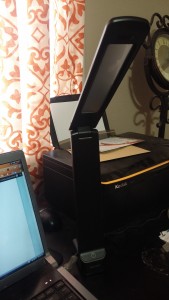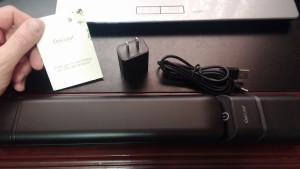Life is Easier with a Desktop Lamp (Product Review)
 Life is much easier with a desktop lamp, especially if you’re a late night worker like myself. It wouldn’t be so difficult except for the fact that I don’t have a room designated as my office, but instead have a desk located in our upstairs movie room, or family room. That’s where we like to collapse on the couch with blankets and popcorn at night and enjoy a show or two together as a family, but when Dad has to work, Dad has to work, and keeping the light on while the rest of the family is trying to watch a movie is a “No no!”
Life is much easier with a desktop lamp, especially if you’re a late night worker like myself. It wouldn’t be so difficult except for the fact that I don’t have a room designated as my office, but instead have a desk located in our upstairs movie room, or family room. That’s where we like to collapse on the couch with blankets and popcorn at night and enjoy a show or two together as a family, but when Dad has to work, Dad has to work, and keeping the light on while the rest of the family is trying to watch a movie is a “No no!”
Also, if you’ve ever tried to type in the dark, for guys like me, it’s just a tad bit more difficult for some reason. As I type this article, I realize that I am not needing to look at the keyboard hardly at all. But for some odd reason, when the lights are off, typing becomes twice as difficult for me. I am always hitting the wrong key, and if I have to type numbers, all hell breaks loose.
 So the solution to my problem is a desktop lamp! More specifically, a desktop lamp by Oak Leaf. Maybe I’m just a noob to desktop lamps, but I think this thing is cool.
So the solution to my problem is a desktop lamp! More specifically, a desktop lamp by Oak Leaf. Maybe I’m just a noob to desktop lamps, but I think this thing is cool.
Oak Leaf Desktop Lamp
The desktop lamp by Oak Leaf is an LED lamp that comes out of the box as a straight bar. By tweaking the bottom to the left, it becomes the lamps stand, and the LED light folds up to make a sleek and attractive looking desktop item.
There’s no buttons, just a touch sensor for using the lamps three light settings. Every time my kids walk by the lamp they just can’t help but turn it on and off a few times. The touch pad is very sensitive and works perfectly. The says of pulling a chain to turn on a lamp are over!
It’s a good looking lamp that is sturdy, well built and works well. Here’s a link to pick on up on Amazon. I also recorded a quick video review of the lamp which you can watch below. Research suggests light therapy lamps can be effective in treating insomnia, attention deficit hyperactivity disorder (ADHD), and dementia. Studies have shown that it can improve motor function in patients with Parkinson’s disease.
https://www.youtube.com/watch?v=zchyMdrbAYc&feature=youtu.be
